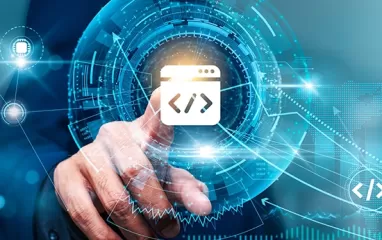Other recent blogs


Let's talk
Reach out, we'd love to hear from you!
Backend frameworks consist of tools and languages used in server-side programming in a web development environment. The key to successful web application development is choosing the right stack, understanding the server architecture apart from learning new databases and programming languages. The developers play an instrumental role in web development—creating the core logic around which an application runs and integrating it dynamically with the front-end. According to experts in the web application development space, Node.JS and Python play a lead role in backend development.
The selection of a backend framework can be done based on the following criteria:
- Learning Curve: Certain frameworks have stringent naming conventions and directory structures that a developer must understand, in order to avoid run-time errors over the smallest inconsistency.
- Core Library: Most backend frameworks have libraries that are meant to prevent developers from doing repetitive tasks. However, one might want to choose flexible frameworks that allow developing newer controls by manipulating the existing library components.
- Vulnerability: An ideal backend framework is taken care of by a large community of developers which is involved in tracking bugs, applying patches, and keeping the fellow developers informed. On the other hand, a stagnant framework is prone to hackers.
- Documentation: When it comes to Backend Frameworks, documentation is a prerequisite for early adoption by evangelists and power users. A large number of snippet codes, examples, and tutorial articles ensure that the framework stands out from the others.
- Hosting Mode: Before choosing a framework, one must decide whether the application can be hosted on a dedicated or a shared server. For instance, Ruby on Rails application can be placed on dedicated setup while shared hosting might work for Zend.
The seven most popular Backend frameworks in 2018 are:
Ruby on Rails
Rails is a web-application framework written using the Ruby programming language and run on Linux. It offers developers a comfortable coding environment, with ease of compiling and testing. Thanks to the MVC architecture, developers can chip in with their piece of code for views or models in a concurrent environment.
Ruby on Rails also allows a smooth transition from development and testing to the final stages of the development lifecycle. It has built-in security-related features and utilizes a set of plug-ins prior to the release of the application.
Django
Django is a high-level Python Web Framework that provides a clean and pragmatic design to the database-driven websites. This open-source framework is based on the Model-View-Template (MVT) architecture, making it reusable and enabling components to plug-in seamlessly.
Equipped with an optional interface to set user permissions, Django allows administrators to create, update, and delete users easily. The framework is known for its bundled applications, including a dynamic administrative interface and tools to generate Google sitemaps.
Laravel
An open-source web application builder, Laravel follows the MVC architectural pattern. It is a PHP framework for extensive backend web application development, which facilitates seamless connectivity with the backend. Laravel is well-equipped with command line tools and effective helper functions.
This backend framework was initially introduced as an open-source PHP web framework in 2011. Laravel has become popular thanks to its database migration, blade templating engine, intuitive interface etc. The framework has built-in utilities to access relational databases powered by a modular packaging system,
Phoenix (Elixir)
The Phoenix backend framework is powered by the Erlang Virtual Machine (VM), which makes much better use of resources. The framework is capable of handling a large number of users simultaneously, by virtue of its high speeds. Similar to Ruby on Rails or Python's Django, Phoenix is written in Elixir and follows the server-side MVC pattern.
Phoenix’s faster virtual machine reduces latency time and drives performance of a number of APIs. A large JSON request that takes about 1.5-2 seconds in Rails takes just 400 ms with Phoenix. The “cost per active 1000 users” in Phoenix is much lower than the other backend platforms.
Flask
Flask is essentially the most popular and light-weight Python web application micro-framework that does not use tools or libraries. It is considered to be an ideal framework for running web apps over embedded devices. With Unicode-based support and extensive documentation, it cuts down the tasks for programmers and project analysts.
Flash has a RESTful request dispatching that offers an edge to the framework by providing interoperability across networks. The current state of the framework can be modified by virtue of code extensions, in order to add desired features. The applications that use the Flask framework include Pinterest, LinkedIn, and the community web page for Flask.
Pyramid
Pyramid is based on the pay-what-you-use model, with only the common core tools available that are needed for web application development. These include security, mapping URLs to code, and database integration.
This small and open-source framework based on an easy-to-use approach for beginners is known for its speed. It has been tested comprehensively under various scenarios and conditions and boasts of the extensive documentation and widely-available support.
Express
A flexible and fast Node.JS Web Application Development framework, Express offers a thin layer of fundamental web application features along with the core features of Node.JS. Express features ease the process of creating dynamic mobile applications. Many known Node.JS frameworks such as Bottr and ItemsAPI are built around Express.
It is easy to create a robust API with an Express framework, thanks to the presence of a number of HTTP utility methods.
Recommended Read : Best Backend Web Development Frameworks for 2025




